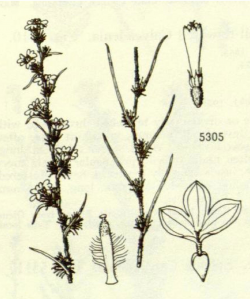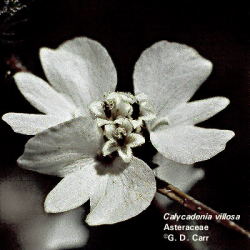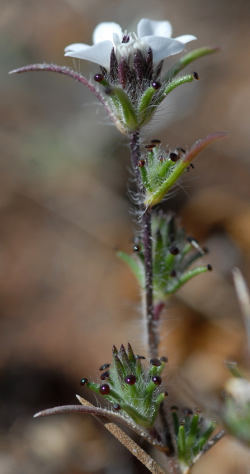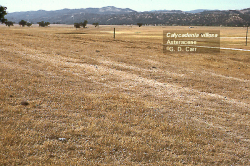
endangered

Illustration from Abrams and Ferris.

Photo © Gerald D. Carr from Calycadenia villosa webpage (see References).

Photo taken in San Luis Obispo Co. © 2011 Chris Winchell.

Photo © Gerald D. Carr from Calycadenia villosa webpage (see References).



This fact sheet was prepared by Dylan M. Neubauer and Dean W. Taylor under award NA04N0S4200074 from the National Oceanic and Atmospheric Administration (NOAA), U.S. Department of Commerce (DOC). The statements, findings, conclusions, and recommendations are those of the authors and do not necessarily reflect the views of the NOAA or the DOC.
© Copyright 2006, Elkhorn Slough Coastal Training Program
Last updated: Nov 21, 2017 19:48
Common Names - dwarf calycadenia, dwarf rosin-weed
Family - Asteraceae (Sunflower Family)
State Status - none
Federal Status - none
Habitat
Open sites in oak woodland or grassland or in rock outcrops in chaparral where competition is limited; on sterile non-productive soils (Franciscan formation, serpentine, or, sandy to fine-gravelly clay soils); 250-850 m (CNPS 2010, CNDDB 2015, CPC 2017).
Key Characteristics
Annual herb; stems to 4.5 dm tall, densely long-hairy and occasionally reddish above, unbranched or branches few and ascending or many and spreading; proximal leaves generally many, stiff, linear, often persistent when senescent, 2–5 cm long; flower heads 1–3 per node, peduncle bracts 3–12, with (0)1 terminal, tack-shaped gland; ray flowers 1–4, rays ± 5 mm long, white to pinkish; disk flowers 5–15, corolla 5–6 mm long; ray cypselae smooth, ± densely appressed long-hairy; disk pappus scales ± 10, lanceolate, acuminate (Carr and Carr 2012).
Flowering Period
May to October
Global Distribution
This California endemic occurs in the central and southern Outer South Coast Ranges (eastern Santa Lucia Range and La Panza Range) in southern Monterey and northern San Luis Obispo counties (CPC 2017).
Reference Population
Camatta Canyon, Los Padres National Forest (San Luis Obispo County)
Discussion
Gerald D. Carr (1977, 1999) has noted variability within this species that suggests two taxa are represented under this name: 1) the northern, typical form in Monterey County (“villosa”), with a more erect, sparingly branched growth habit, showy flower heads, and unequally lobed ray flowers; and 2) the southern (La Panza) form (“depressa”), with a shorter, highly branched growth habit, smaller flower heads, and equally lobed ray flowers.
In a 1993 review of the phylogenetics of Calycadenia, Bruce G. Baldwin states: “Recognition that C. hooveri and C. villosa preserve (near-) relict chromosomal arrangements that may be of pivotal importance to understanding chromosome evolution in Calycadenia increases the conservation priority of these two rare species.”
Conservation and Threats
The locality for the type specimen collected by David Douglas has not been ascertained. Prior to 1999, only two localities were documented, collectively composed of less than 1,000 plants (Wilken 2000). One occurrence, based on a 1946 Hoover specimen was extirpated by the construction of the San Antonio Reservoir (CNDDB 2015). In the late 1990s, field work conducted by the Santa Barbara Botanic Garden located 82 sites in southern Monterey and northern San Luis Obispo counties (Wilken 2000, CPC 2017). Varying population numbers were determined to be correlated with winter precipitation amounts (Wilken 2000, CPC 2017).
Thirty-two occurrences out of sixty total occur on U.S. Army–managed Fort Hunter Liggett, where some have been impacted by military training activities, and others are threatened by dust, trampling, grazing, and OHV use (CNDDB 2015). One of two Camp Roberts occurrences is under putative protection as it occurs with Federally Threatened Santa Lucia purple amole (Chlorogalum purpureum var. purpureum) (CNDDB 2015). Four occurrences in the La Panza Range occur within the Los Padres National Forest; these are threatened by OHV and recreational use and road maintenance (CNDDB 2015). In one area dwarf calycadenia co-occurs with federally threatened Camatta Canyon amole (Chlorogalum purpureum var. reductum) (Wilken 2000, CPC 2017).
References
Abrams L. and Ferris R. S. 1960. Illustrated flora of the Pacific States, Vol. IV. Stanford University Press, Stanford, CA.
Baldwin, B. G. 1993. Phylogenetics of Calycadenia (Compositae) based on ITS sequences of nuclear ribosomal DNA: chromosomal and morphological evolution reexamined. American Journal of Botany 80(2):222–238.
Buchmann, S., L. D. Adams, A. D. Howell, and M. Weiss. 2010. A study of insect pollinators associated with DoD TER-S flowering plants, including identification of habitat types where they co-occur by military installation in the western United States. Project Number 08-391. Department of Defense Legacy Resource Management Program. http://oai.dtic.mil/oai/oai?verb=getRecord&metadataPrefix=html&identifier=ADA534396 [acc. 8 January 2015].
California Native Plant Society (CNPS), Rare Plant Program. 2010. Calycadenia villosa, Inventory of Rare and Endangered Plants (online edition, v8-02). California Native Plant Society, Sacramento, CA. http://www.rareplants.cnps.org/detail/1602.html [acc. 7 January 2015].
California Natural Diversity Database (CNDDB). 2015. California Department of Fish and Wildlife RareFind 5. [acc. 7 January 2015].
Carr, G. D. 1975. Calycadenia hooveri (Asteraceae) a new tarweed from California. Brittonia 27:136–141.
Carr, G. D. 1977. A cytological conspectus of the genus Calycadenia (Asteraceae): an example of contrasting modes of evolution. American Journal of Botany 64:694-703.
Carr G. D. 1999. Calycadenia villosa DC. Calycadenia DC., Systematics and evolution of the Madiinae: tarweeds to silverswords gallery of genera, University of Hawaii at Manoa, Department of Botany. http://www.botany.hawaii.edu/faculty/carr/cal_vil.htm [acc. 7 January 2015].
Carr, R. L. and G. D. Carr. 2006. Calycadenia villosa, in Flora of North America Editorial Committee (eds.) 1993+. Flora of North America North of Mexico. 19+ vols. New York and Oxford. Vol. 21. http://www.efloras.org/florataxon.aspx?flora_id=1&taxon_id=250066283 [acc. 21 November 2017].
Carr, R. L. and G. D. Carr. 2013. Calycadenia villosa, in Jepson Flora Project (eds.) Jepson eFlora. http://ucjeps.berkeley.edu/cgi-bin/get_IJM.pl?tid=1889 [acc. 7 January 2015].
Center for Plant Conservation (CPC). Calycadenia villosa, CPC Plant Profile. https://saveplants.org/national-collection/plant-search/plant-profile/?CPCNum=8101 [acc. 21 November 2017].
Stephenson, J. R. and G. M. Calcarone. 1999. Southern California mountains and foothills assessment: habitat and species conservation issues. Chapter 5—Potentially vulnerable species: plants. Calycadenia villosa (dwarf calycadenia). General Technical Report GTR-PSW-175. Albany, CA: Pacific Southwest Research Station, Forest Service, U.S. Department of Agriculture. http://www.fs.fed.us/psw/publications/documents/gtr-172/gtr-172-ch5.pdf [acc. 7 January 2015].
Wilken, D. 2000. Rare plant survey at Fort Hunter Liggett: purple amole (Chlorogalum purpureum), dwarf calycadenia (Calycadenia villosa), and Santa Lucia mint (Pogogyne clareana). Technical Report 2. Santa Barbara Botanic Garden, Santa Barbara, CA.
